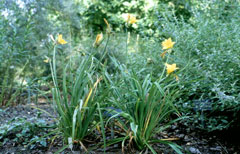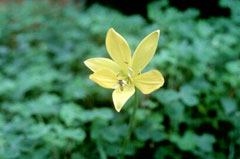 |
|
(c) 2010 Ken Fern & Plants For A Future |
 |
| (c) 2010 Ken Fern & Plants For A Future |
Translate this page:
Summary
The yellow-flowered H. dumortieri is a vigorous, clump-forming plant and one of the first species to flower in early summer. H. middendorffii is an herbaceous perennial growing to 0.9m. It has linear arching leaves with golden yellow or orange flowers that are slightly fragrant. It can grow in semi-shade (light woodland). Edible Parts include the Flowers and Leaves. Medicinal Uses include: Antidote; Diuretic. Other Uses include: Weaving. The tough dried foliage is plaited into cord and used for making footwear. Hemerocallis species,
Daylilies are a flowering plant in the genus Hemerocallis. The flowers are usually large and showy, with six petals. They come in various colours: yellow, orange, pink, red and purple. The daylily is native to Eurasia and is found in many parts of the world. The flowers typically last for one day, hence the name ‘daylily’. They are straightforward to grow, with many forms tolerant of almost total neglect. Daylilies are widely used as a food crop in China and Japan. The genus comprises about 20 species. The Common DayLily H. fulva is more heat tolerant and grows well in drier climates. All parts of the plants are edible, with the flowers used more frequently. Eat the flowers raw when fully open. The petals are thick, crisp and juicy, with a delicate sweetness at their base due to their nectar. They are nutritious, containing reasonable quantities of protein, carbohydrates, iron and vitamin A. They are a great addition to the salad bowl. Cook flower buds; they taste like green beans. In the Orient, the flowers are dried and used as a flavouring and thickener in soups and sauces. The young shoots have a pleasant sweet flavour, making an excellent cooked vegetable. Depending on the species, young shoots are harvested from late winter and for much of the spring. Many species also produce edible nutty-flavoured young roots eaten raw or cooked.
Many Hemerocallis species are excellent weed-excluding ground cover, succeeding under and around trees and shrubs. Plant clump-forming species such as H. dumortieri, H. lilioasphodelus and H. middendorffii 50cm (18in) apart. Running species such as H. fulva are planted up to 1m (3ft) apart. Form: Irregular or sprawling. Bloom Color: Yellow. Main Bloom Time: Early fall, Late summer.
Physical Characteristics

 Hemerocallis middendorffii is a PERENNIAL growing to 0.9 m (3ft) by 0.5 m (1ft 8in) at a medium rate.
Hemerocallis middendorffii is a PERENNIAL growing to 0.9 m (3ft) by 0.5 m (1ft 8in) at a medium rate.
See above for USDA hardiness. It is hardy to UK zone 5 and is not frost tender. It is in flower from June to July. The species is hermaphrodite (has both male and female organs). The plant is self-fertile.
It is noted for attracting wildlife.
Suitable for: light (sandy), medium (loamy) and heavy (clay) soils and can grow in heavy clay soil. Suitable pH: mildly acid, neutral and basic (mildly alkaline) soils. It can grow in semi-shade (light woodland) or no shade. It prefers dry or moist soil.
UK Hardiness Map
US Hardiness Map
Synonyms
Plant Habitats
Woodland Garden Sunny Edge; Dappled Shade; Ground Cover; Meadow; Cultivated Beds;
Edible Uses
Edible Parts: Flowers Leaves Shoots
Edible Uses:
Leaves and young shoots - cooked[105, 116, 177, 183]. They must be consumed when very young or else they become fibrous[K]. Flowers and flower buds - raw or cooked[105, 177, 183]. The flowers can be dried and used as a thickener in soups etc. The flower buds contain about 43mg vitamin C per 100g, 983 IU vitamin A and 3.1% protein[205].
References More on Edible Uses
Medicinal Uses
Plants For A Future can not take any responsibility for any adverse effects from the use of plants. Always seek advice from a professional before using a plant medicinally.
Antidote Diuretic Vitamin C
The juice of the roots is an effective antidote in cases of arsenic poisoning[205]. A tea made from the boiled roots is used as a diuretic[205].
References More on Medicinal Uses
The Bookshop: Edible Plant Books
Our Latest books on Perennial Plants For Food Forests and Permaculture Gardens in paperback or digital formats.

Edible Tropical Plants
Food Forest Plants for Hotter Conditions: 250+ Plants For Tropical Food Forests & Permaculture Gardens.
More

Edible Temperate Plants
Plants for Your Food Forest: 500 Plants for Temperate Food Forests & Permaculture Gardens.
More

More Books
PFAF have eight books available in paperback and digital formats. Browse the shop for more information.
Shop Now
Other Uses
Weaving
The tough dried foliage is plaited into cord and used for making footwear[205]. Plants form a spreading clump and are suitable for ground cover when spaced about 45cm apart each way[208]. The dead leaves should be left on the ground in the winter to ensure effective cover[208]. (This report was for a plant labelled H. middendorfiana, which I have assumed is a mis-spelling of this species[K]). Attractive flowers. 1. Nectary - Flowers rich in nectar and pollen:
Yes – Daylilies produce abundant nectar, attracting various pollinators, including bees and butterflies.
2. Wildlife - Food (Fruit, Seeds, Leaf litter, Shelter, Nesting, Roosting):
Yes – The flowers and young buds of daylilies are edible and can be consumed by both humans and wildlife. The dense foliage can provide some shelter for small wildlife, though they are not typically used for nesting.
3. Invertebrate Shelter (Overwintering sites, Leaf litter, Groundcover):
Yes – Daylilies can provide ground cover and some overwintering habitat for beneficial insects, particularly in their leaf litter.
4. Pest Confuser (Smell):
No – Daylilies do not have a strong aroma that would effectively confuse pests.
Special Uses
Food Forest Ground cover
References More on Other Uses
Cultivation details
Landscape Uses:Border, Container, Ground cover, Massing, Seashore. Succeeds in most soils[1], including dry ones, preferring a rich moist soil and a sunny position[111] but tolerating partial shade[88]. Plants flower less freely in a shady position though the flowers can last longer in such a position[205]. Grows well in heavy clay soils. Succeeds in short grass if the soil is moist[1]. Prefers a pH between 6 and 7[200]. Hybridizes freely with other members of this genus[200]. Individual flowers are short-lived, but the plant produces a succession of blooms and also flowers again in late summer[205]. The plant has a fibrous root system that does not extend far[205]. Plants take a year or two to become established after being moved but then form large clumps[200, 187]. Plants seem to be immune to the predations of rabbits[233]. The plants are very susceptible to slug and snail damage, the young growth in spring is especially at risk[200]. Special Features:
Attractive foliage, Not North American native, Naturalizing, Attracts butterflies, Suitable for cut flowers, Fragrant flowers.
References Carbon Farming Information and Carbon Sequestration Information
Temperature Converter
Type a value in the Celsius field to convert the value to Fahrenheit:
Fahrenheit:
The PFAF Bookshop
Plants For A Future have a number of books available in paperback and digital form. Book titles include Edible Plants, Edible Perennials, Edible Trees,Edible Shrubs, Woodland Gardening, and Temperate Food Forest Plants. Our new book is Food Forest Plants For Hotter Conditions (Tropical and Sub-Tropical).
Shop Now
Plant Propagation
Seed - sow in the middle of spring in a greenhouse. Germination is usually fairly rapid and good. Prick out the seedlings into individual pots when they are large enough to handle. Grow the plants on for their first winter in a greenhouse and plant out in late spring[K]. Division in spring or after flowering in late summer or autumn[200]. Division is very quick and easy, succeeding at almost any time of the year[K]. Larger clumps can be replanted direct into their permanent positions, though it is best to pot up smaller clumps and grow them on in a cold frame until they are rooting well. Plant them out in the spring.
Other Names
If available other names are mentioned here
Native Range
TEMPERATE ASIA: Russian Federation (Kurile Islands, Habarovskij kraj, Primorye, Amur, Sakhalin), China (Heilongjiang Sheng, Jilin Sheng, Liaoning Sheng), Korea (east), Japan (Hokkaidô)
Weed Potential
Right plant wrong place. We are currently updating this section.
Please note that a plant may be invasive in one area but may not in your area so it's worth checking.
Conservation Status
IUCN Red List of Threatened Plants Status :

Growth: S = slow M = medium F = fast. Soil: L = light (sandy) M = medium H = heavy (clay). pH: A = acid N = neutral B = basic (alkaline). Shade: F = full shade S = semi-shade N = no shade. Moisture: D = dry M = Moist We = wet Wa = water.
Now available:
Food Forest Plants for Mediterranean Conditions
350+ Perennial Plants For Mediterranean and Drier Food Forests and Permaculture Gardens.
[Paperback and eBook]
This is the third in Plants For A Future's series of plant guides for food forests tailored to
specific climate zones. Following volumes on temperate and tropical ecosystems, this book focuses
on species suited to Mediterranean conditions—regions with hot, dry summers and cool, wet winters,
often facing the added challenge of climate change.
Read More
Expert comment
Author
Trautv.&C.A.Mey.
Botanical References
58200266
Links / References
For a list of references used on this page please go here
Readers comment
| Add a comment |
|
If you have important information about this plant that may help other users please add a comment or link below. Only comments or links that are felt to be directly relevant to a plant will be included. If you think a comment/link or information contained on this page is inaccurate or misleading we would welcome your feedback at [email protected]. If you have questions about a plant please use the Forum on this website as we do not have the resources to answer questions ourselves.
* Please note: the comments by website users are not necessarily those held by PFAF and may give misleading or inaccurate information.
To leave a comment please Register or login here All comments need to be approved so will not appear immediately.
|
Subject : Hemerocallis middendorffii
|
|
|
|